#flightless cormorant
Text

Galápagos flightless cormorants
By: Toshio Asaeda
From: Natural History Magazine
1936
46 notes
·
View notes
Text
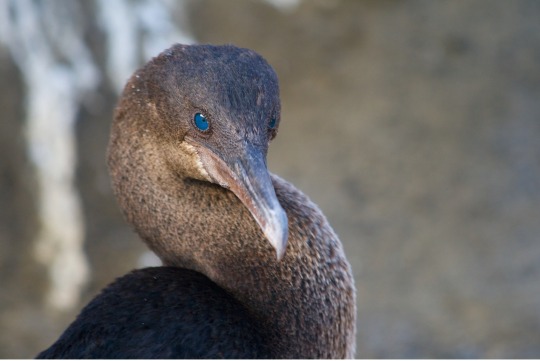
Flightless cormorant - Galapagos Islands
By Court Whelan, Ph.D.
#court whelan ph.d.#photographer#flightless cormorant#cormorant#bird photography#animal#galapagos islands#nature
10 notes
·
View notes
Text
Animal of the Day!
Flightless Cormorant (Phalacrocorax harrisi)
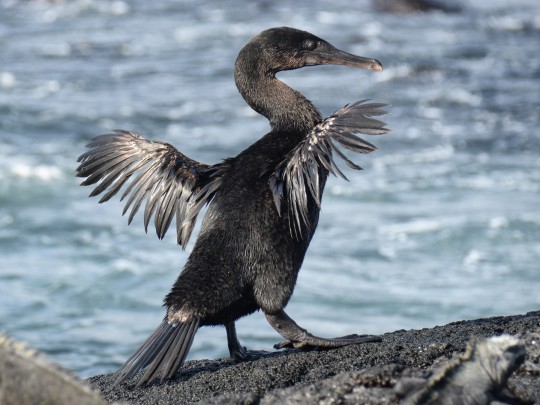
(Photo by Pauline Banducci)
Conservation Status- Vulnerable
Habitat- Galapagos Islands
Size (Weight/Length)- 5 kg; 91 cm
Diet- Fish; Squid; Octopus
Cool Facts- Due to spending its entire evolutionary life on the Galapagos Islands, the flightless cormorant is a truly unique bird. It is the only species of cormorant that is unable to fly. While their wings are much too small to fly, these cormorants can dive up to 70 meters in less than 3 minutes. While they will eat sea animal that can fit in their mouth, they prefer fish and octopus. Despite having the ability to dive, their feathers are not waterproof. This means that they have to spend a considerable amount of time sunning themselves to dry off and prevent becoming waterlogged. Due to a recent increase in individuals due to conservation efforts, the flightless cormorant is no longer considered endangered!
Rating- 11/10 (Evolution in the making.)
#Animal of the day#Animals#Birds#Sunday#April 24#Flightless cormorant#Cormorant#biology#science#conservation#the more you know
346 notes
·
View notes
Text
BOTD: Flightless Cormorant

^image credit: putneymark, Wikipedia
Flightless Cormorant (nannopterum harrisi)
The Flightless Cormorant, as its name suggests, is the only species of cormorant which has lost the ability to fly. Also called the Galapagos Cormorant, it is endemic to the Galapagos Islands. While swimming, it does not use its wings to 'fly' through the water like penguins do, but rather tucking in their wings and kicking their powerful hind legs to hunt for their prey.
#tropical birds#flightless cormorant#cormorant#cormorants#galapagos cormorant#galapagos islands#galapagos#bird facts#bird fact#bird fact of the day#bird of the day#birdoftheday#botd#birdfactoftheday#bird lovers#bird lover#ornithology#birding#birdwatching#cool birds#cool animals#wildlife#birdlife#bird watching
42 notes
·
View notes
Text
Tumblr Sexyman: Animal Edition - I'M BAAAAACK!
Finally sorted out the problem with my polls/lists...I think
We should now return to a more regular broadcasting schedule
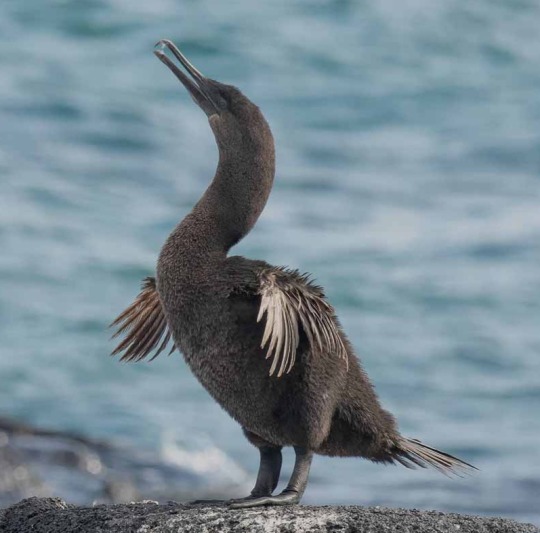








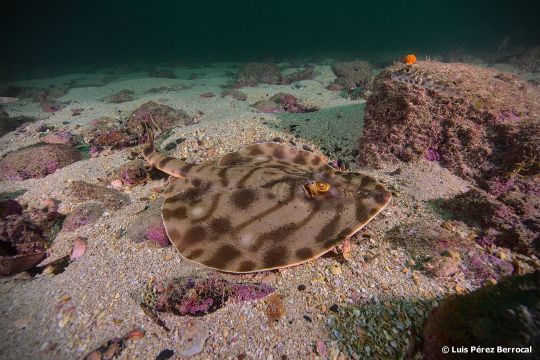
#tumblr sexyman poll#animal poll#poll#polls#tumblr polls#tumblr sexyman: animal edition#animal sexyman#tumblr sexyman#animals#vote#snake#snakes#frogs#frog#shrimp#birds#flightless cormorant#rays#panray
1 note
·
View note
Text
i did my best to include lots of birds. sorry if i missed your favorite or miscategorized it! i am no bird expert
#birds#birdwatching#bird photography#birdblr#polls#tumblr polls#somanypolls#there are a lot of cool birds out there#over 10000!!#and some are not easily categorized lol
5K notes
·
View notes
Text
The Spectacle(d Cormorant) - an informative post about an underrated extinct bird

(Artwork by me. Halfly based on the artwork by Joseph Wolf.)
Just something out of the ordinary from before. I am getting tired from posting all those comics and stuff on here, so here's a repost of my depiction of one of my all-time favorite extinct birds - the life, the moment, the spectacle itself - the spectacled (or Pallas's) cormorant, as well as a bunch of facts about it below this because I care about this bird so much and will protect it with all my life if it still existed.
You may ask, why am I so into this nerdy-looking bird? It's not like it's THAT special or anything - we still have at least 40 other cormorant species alive on earth - 3 of them in the same genus as the spectacled cormorant.
The reason is simple - no one ever talks about it or even has an idea on what it is, even though humans were the sole cause of its extinction. (And believe it or not, cormorant culling IS still a thing, but that's a different story for now.)
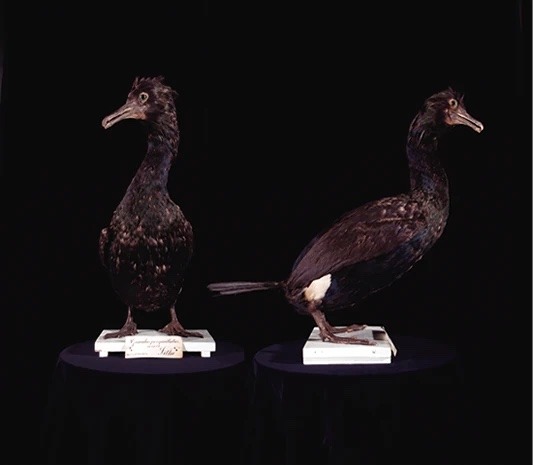
(Specimen kept at the Naturalis Biodiversity Center in Leiden, the Netherlands.)
Large, stupid, clumsy, ludicrous in looks. That was how others, including Georg Steller, the discoverer of the bird, described the spectacled cormorant. It was, perhaps, the largest of all cormorants known to exist, rivalling the Galápagos flightless cormorant in length, but was way heavier than the latter. Due to its large size, it was probably flightless, but studies of its wings have shown that it was more likely reluctant to do so due to its lack of natural predators (besides Arctic foxes) while residing in its former habitat - the Commander/Komandorski Islands in Kamchatka Krai of Russia. Occasionally, some of these birds would get lost and end up on the Kamchatka Peninsula, which led to its consumption by the locals.
However, it wasn't until the 1820s when their extinction was hastened. The Russian-American Company started to transfer Unangan (Aleut) people to the islands, and, to no surprise, they found this cormorant easy to hunt. As Steller said on his journey in 1741, the spectacled cormorant was also rather delicious, unlike most other cormorants. Along with how it was abundant on the Commander Islands, this was most likely the exact reason why the Unangan people consumed it whenever they could not catch enough fish to sell or feed their families.
That marked the end of the legacy of the spectacled cormorant. It vanished from the islands and the world in the 1850s, and was never heard from anyone ever again.
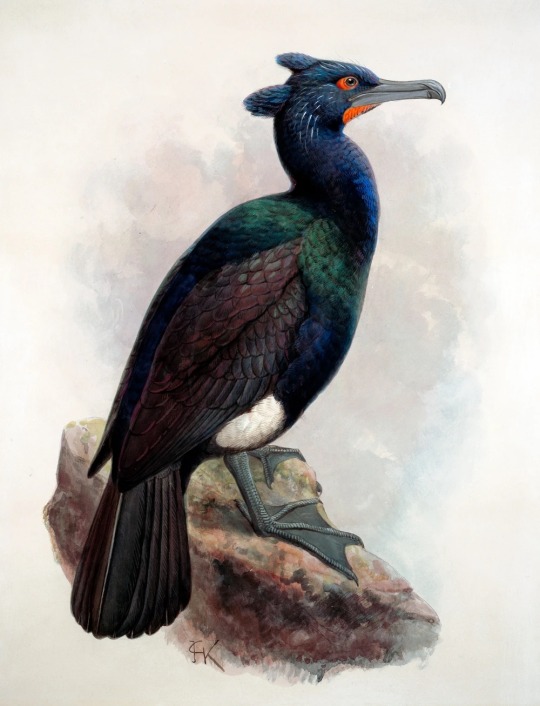
(Artwork by J. G. Keulemans.)
The reason why it might have been forgotten by man was probably due to there only being six known specimens of this bird collected (all apparently by the same person, Governor Kuprianof), and only one or two of those specimens are currently up for display in the whole world.
The spectacled cormorant died like the dodo, but unlike the dodo, it was quickly forgotten by the people who caused its rapid extinction. By the time we wanted to care about it, it was already gone.
170+ years have passed. People like me still remember this bird, wanting to do anything to bring it back to life, or just imagining it while it was still in its glory - plummeting into the cold seas to catch a mouthful of fish, as it clumsily swims back to the shore to dry its wings. A beautiful bird that met a rather depressing fate.
#extinct birds#bird art#spectacled cormorant#recently extinct#extinct animals#i can't draw backgrounds#extinction#lineless art#digital artwork#informative post#fact post#bird facts#cormorant#seabirds
240 notes
·
View notes
Text
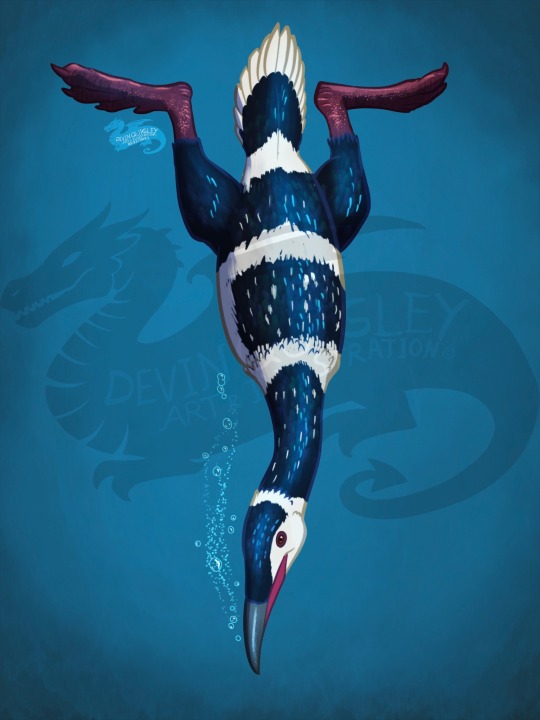
Paleovember 2023, Hesperornis!
Dating back to the Late Cretaceous (and possibly right up to the end of the period), Hesperornis was a flightless, cormorant-like bird that measured up to 6 feet long. It was a marine creature, swimming in the Western Interior Seaway that stretched from Canada, through Kansas, and into Mexico, and had to deal with all of the other marine horrors that swam through there as well. Being on the small side in this nightmare aquarium, Hesperornis survived by being agile in the water, while keeping itself sustained with a beak lined with needle-sharp teeth. Unlike penguins, it wouldn't have been able to walk on it's hind legs, and probably hauled itself on it's belly onto shore like a seal.
#cretaceous period#Hesperornis#bird#sea birds#paleontology#paleoart#Paleovember#illustration#art#artwork#digitalart#drawing#animal art#procreate#prehistoric#artist on tumblr
80 notes
·
View notes
Text
Spectember D19: Commensalism

In an alternative earth where the late cretaceous went very smooth on its transitional event (multiple minor extinctions and a non-KPg) caused pterosaurs on marine environment to experiment in new behaviors and so lose flight, and in dozen million years those derived pterosaurs started to become specialized swimmers that expanded into new forms, many penguin and cormorant like forms, long manta shaped wanderers of different feeding behaviors and a strange long necked like form, but nothing could compare to the strange and large boatbills, they sort of converged with azhdarchids with their body:head ration being around ¼ of the body size, but unlike those lack long necks or large limbs for their aquatic lifestyle, with their large head and beaks adapted to remain afloat near the surface, being limited to swim in the surface, which many animals take advantage of their length and live alongside these, including an unique squamate that adapted to live on these big marine flightless pterosaurs.
The Bowstick Icthoherpetes is part of a minor radiation of the cretaceous saltwater mosasaurs, although many diverged into thunniform body types few average forms similarly to their cretaceous relatives remained, the Bowsticks is one of few last descendant of the lineage of these, this small reptile over time adopted the behavior of stick alongside large animals to eat what they leave behind, though being air breathing limit the options of host and the Boatbill became the most compatible to live with, as their anatomy restricted them to be surface dwellers with a limited range of diving.
The way it attaches to their host is simple as with animals like geckoes, their fore fins have evolved rows of comb structured scales that extend in the 4-digit pads that physically attach firmly on the beak of the boatbill, often near the upper part for the access to air. They can regulate their air intake and keep it relatively slow oxygen consuming so they can last underwater for an hour, only if they need to breath, they can detach from their host boatbill and reach the surface only to swim fast before the big pterosaur drift away.
56 notes
·
View notes
Note
Conversion student here with a random question/debate topic
Would penguins be considered kosher?
Obviously, they’re not in the list of non-kosher birds, but they give off a less-than-kosher vibe.
What about other flightless birds? I don’t know much about ostriches and emus, but they seem like birds that would be considered dores (I would personally include the ability to bludgeon other creatures to death as something that feels decidedly non-kosher).
Back on penguins, are they closer to other swimming kosher birds (e.g ducks) or other flightless non-kosher birds?
I haven’t seen it specifically mentioned, but I can feel it in my bones that more than one rabbi has devoted a significant amount of time and energy into this topic
No, penguins are not kosher.
Why?
Well, first we understand which birds are kosher by which birds aren't on the list of non-kosher birds in the Tanakh, which are:
-Eagle
-Vulture
-Black vulture
-Kite
-All falcons
-All ravens
-Ostrich
-Nighthawk
-Seagull
-All hawks
-Little owl
-Cormorant
-Great owl
-White owl
-Pelican
-Bustard
-Storks
-All herons
-Hoopoe
-Bat (yes a bat isn't scientifically a bird but the word used in the Tanakh is "הָע֔וֹף", which technically translates as "those who fly")
The Mishnah elaborates that a kosher bird is one that:
-Is not a bird-of-prey
-Has an extra/elongated toe
-Has a crop
-Has a "peelable" gizzard (has a layer of skin in the gizzard that can be peeled by hand)
-Doesn't split its toes when standing on a string (doesn't put two in front and two behind) (like how a parrot perches, so parrots aren't kosher)
Additionally, in practice, which birds are kosher are those that have a Mesorah (tradition) of being kosher. So, kosher birds are generally those in the Phasianidae family (although the Mesorah of eating peafowl has been shaky, so generally most Jews won't eat peafowl), the Anatidae family, and the Columbidae family. Most commonly eaten birds today are: Chicken, Turkey, Goose, Duck, Pigeon, Quail, and Pheasant. Turkeys are kosher even though they are flightless New World birds with no Mesorah because they've attempted to mate with chickens and are similar enough to other pheasant-like birds, and because they meet the qualifications of a kosher bird. Although still, some Jews won't eat turkeys. The Shulchan Aruch also established that if a bird has a long-standing Mesorah of being kosher, then even if it's missing one qualification, it's still kosher .(geese don't have crops, for example).
So, penguins aren't kosher because:
-They hunt
-They have a really tiny hallux
-They don't have a crop
-There's absolutely no Mesorah of them being kosher and they're in no way similar to kosher birds
And as for ostriches, they're already in the list of non-kosher birds.
Now, if you really want to have a debate, talk to your fellow students and Rabbi about why turkeys are/aren't considered kosher because hoo boy is it a debate starter haha
57 notes
·
View notes
Text
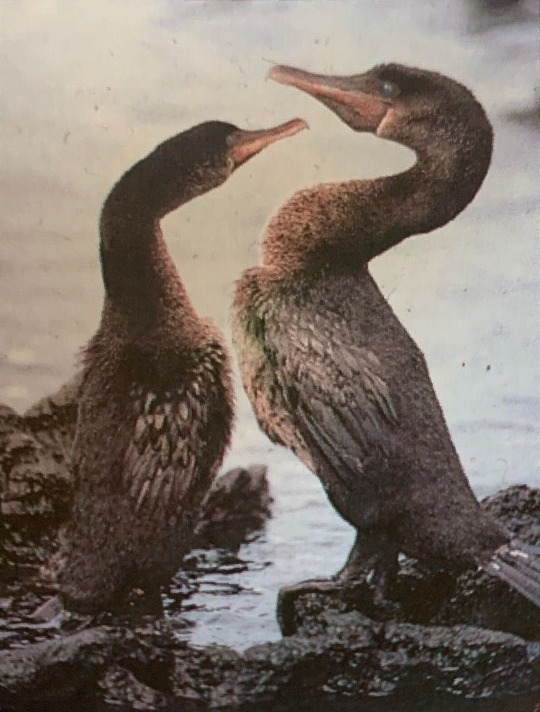
Flightless cormorant
By: Unknown photographer
From: WWF Threatened Animals
1986
48 notes
·
View notes
Text
my first bout at poetry be nicey to me forever okaysie i am extremely depressed
Gender bomb
Fly the French flag with credit to Jacques-Louis
I’m a kiddycore dictator
Copyrighted my loneliness so that
no one else can share it
~~~~~~~~~~~~~~~~~~~~~~~~~~~~~~~~~~~~~~~~~~~~~~~~~~~~~~~~~~~~~~~
Unit
Stick your wire in my head
So I can feel your orders
And I’ll go out and gun them down
inflict on them your horrors
You take me out all wet and warm
and in my eyes I beg for home
so a hollow cord enters my gut
and I’m laid back in the hull
~~~~~~~~~~~~~~~~~~~~~~~~~~~~~~~~~~~~~~~~~~~~~~~~~~~~~~~~~~~~~~~
Good girl
Every ridge of your fingerprint
I feel against my temple
I push into you with a little mewl
My body is your temple
~~~~~~~~~~~~~~~~~~~~~~~~~~~~~~~~~~~~~~~~~~~~~~~~~~~~~~~~~~~~~~~
Seasonal leaves
It’s autumn
She said it was eternal summer
That the trees would be green forever
When the leaves turned orange I asked again
And again I was told not to worry
from across the house
And now it’s fall
and it’s left
I won’t survive the winter
~~~~~~~~~~~~~~~~~~~~~~~~~~~~~~~~~~~~~~~~~~~~~~~~~~~~~~~~~~~~~~~
Seattle girls
The compression made it better
I loved the way you sang
I liked the nasal tone of voice
And the sparkle in your fangs
I wanted to be just like you
and cover midwest emo Weezer
but as I bleed my fingers dry
there are no calluses on my finger
~~~~~~~~~~~~~~~~~~~~~~~~~~~~~~~~~~~~~~~~~~~~~~~~~~~~~~~~~~~~~~~
Not what we’re looking for
No one wants me
not in the sappy sad way
In a way that almost makes me proud
the machine doesn’t like to grind me
but I keep sticking fingers in
I need it to live and love
Over and over again
~~~~~~~~~~~~~~~~~~~~~~~~~~~~~~~~~~~~~~~~~~~~~~~~~~~~~~~~~~~~~~~
A sad story about a girl with a snuff kink
Spare me the embarrassment
of asking you to kill me
I’m digging my own grave for you
Carving out my tombstone
Saying goodbye to all my friends
and now you ask “are you sure?”
~~~~~~~~~~~~~~~~~~~~~~~~~~~~~~~~~~~~~~~~~~~~~~~~~~~~~~~~~~~~~~~
Go to her
You’ll go surf some couches
Orgy in the bathroom
Traveling across the country
Anything for your girl
There’s a treadmill under your feet
And you can drive a car
And you have all the room to breath
I'll be in my room
~~~~~~~~~~~~~~~~~~~~~~~~~~~~~~~~~~~~~~~~~~~~~~~~~~~~~~~~~~~~~~~
Flightless birds
Look at the emu run!
And the penguin dive!
And cassowary kicks!
And the kākāpōs hide!
And the cormorant fish!
~~~~~~~~~~~~~~~~~~~~~~~~~~~~~~~~~~~~~~~~~~~~~~~~~~~~~~~~~~~~~~~
All these plans
Would you like to go to a concert
Sometime
Or maybe we could walk by a river
Sometime
If we go out for lunch I’ll pay for your food
Sometime
We could play video games together
Sometime
Or just fall asleep on each other
Sometime
If you just want to talk, that’s fine
Sometimes
I’d like to just say good morning
Some time?
~~~~~~~~~~~~~~~~~~~~~~~~~~~~~~~~~~~~~~~~~~~~~~~~~~~~~~~~~~~~~~~
6 notes
·
View notes
Text
Regional Cramorant!

A regional form of Cramorant I made for Pokemon Zenith and Nadir, a Pokemon region I am working on based on Ecuador and the Galapagos Islands! It is a Normal/Water Type based on the flightless cormorants that live on the islands.
The Cramorant who live within the archipelago of Gosdor have fewer predators than in Galar, and because of this they spend most of their time living on rocky shores. Their wings have adapted to this new lifestyle and shrunk due to a lack of use, rendering them flightless. However, their swimming skill has increased in return, and it can swim better than Galarian Cramorant can. Because of the lack of threat, these Cramorant are more trusting and will approach humans without fear, which have lead to them becoming quite pampered by humans overtime.
6 notes
·
View notes
Text
Freshwater Hesperornitheans
Brodavis by Scott Reid, a taxon that occurs in freshwater environments.
Hesperornithes are some of the most iconic extinct birds. Or rather, the larger, marine members of this group like Hesperornis or Canadaga are; little discussion is there to be made of the myriad membrs of this group that not only were smaller, but lived in freshwater.
Typically, when such animals are brought up, they’re considered “primitive” members of the group, still capable of flight. But not only did the invasion of freshwater habitats began late in the evolution of these birds, they were equally as flightless as their marine cousins. This is quite extraordinary, a group of marine flightless seabirds having invaded freshwater biomes, some as far inland as Mongolia!
Now, the invasion of freshwater bodies by marine tetrapods is not new. Freshwater seals, dolphins and manatees co-exist with us today, and in the past various lineages of plesiosaurs invaded freshwater. Likewise, flightless diving birds occur in freshwater, in the form of some highly endangered grebes. But flightless seabirds invaded deep into continental waterways is unprecedented, occuring in ecosystems not only dominated by terrestrial (and freshwater) predators but also far inland. Most freshwater diving birds today are of the flying variety, not only to evade predators but to cover distances as freshwater environments are seldomly permanent.
Seeing as hesperornitheans were functionally similar to cormorants and ducks it makes one wonder if cormorants would have gone flightless in a world without predatory mammals. Again, these birds rely on flight for migration and seeking new territories, something these freshwater hesperornitheans didn’t have access to, but were successful enough to expand far and wide.
More studies should be conducted on their biology, as these freshwater birds are quite unlike any aquatic tetrapods alive today.
2 notes
·
View notes
Text
It took me an embarrassingly long time to click in my head that cormorants are the flightless birds, my brain didn't immediately click the image to the name
3 notes
·
View notes
Photo
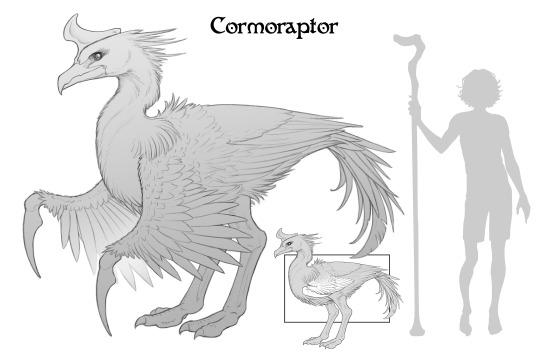
The Cormoraptor: a brand new fantasy beastie from my new shiny world. A domesticated, flightless avian which is often used to pull carts or serve as mounts for a single rider.
Hardly the most original concept, but I ain’t shootin’ for the moon, here. Just having fun. Originality is a trap, and I can’t be bothered trying to spend energy trying to break the molds. I did like the long arm claws, though. I imagined them being used to assist in forward propulsion over difficult terrain.
Animals used for inspiration: cormorant, harpy eagle, ostrich, cassowary, and various other fantasy terror bird types.
6 notes
·
View notes